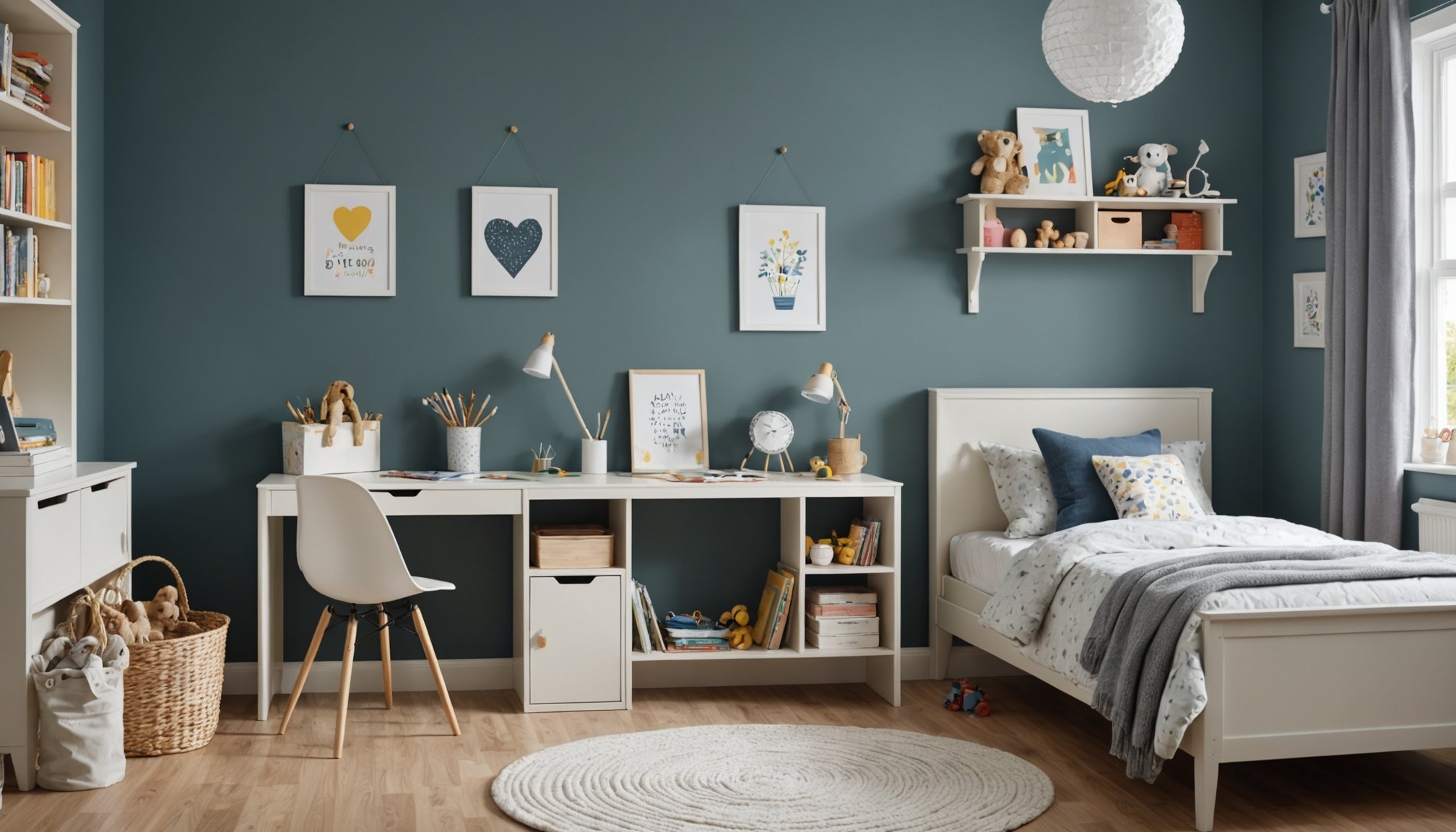Overview of Kid-Safe Paints
Kid-safe paints are specially formulated to ensure the safety and health of children. Unlike conventional paints, which often contain harmful chemicals like volatile organic compounds (VOCs), kid-safe paints are designed to be non-toxic and free from dangerous additives. This makes them a preferred choice for parents concerned about creating a healthy environment in children’s rooms.
Non-toxic paint options are characterized by low or zero VOC levels, absence of lead and heavy metals, and lack of formaldehyde. They also often contain natural ingredients, aiding environmental responsibility. These characteristics are crucial as they help in minimising the risk of respiratory issues, allergies, or other health concerns that traditional paints might cause.
Also to discover : Exploring Optimal Approaches for Retrofitting Double Glazing in York’s Historic Listed Buildings
Exposure to conventional paints can lead to various health risks, such as dizziness, headaches, or long-term respiratory problems, due to inhaling toxic fumes during application and drying. These risks make it essential to adhere to paint safety standards, ensuring that paints meet international safety certifications before use in spaces where children spend significant time. By choosing non-toxic paints, parents not only safeguard their children’s health but also contribute to a more sustainable planet.
Top Brands of Kid-Safe Paints
Choosing the correct kid-safe paint can be daunting, with numerous brands promising non-toxic and durable solutions. Here’s a detailed exploration of the best options available, based on reviews and expert opinions.
Also read : Mastering Seasonal Allergy Relief: Top Tips for Indoor Plant Management in Your London Apartment
Brand 1 Review
One standout in the market is Brand A, known for its exceptional non-toxic formula and vibrant colour options. It offers excellent coverage, often needing only one coat to achieve the desired effect. Users frequently praise its easy application and quick drying time. Expert reviewers echo these sentiments, noting that the paint doesn’t emit any harsh odours, making it perfect for rooms frequented by children.
Brand 2 Review
Brand B distinguishes itself through its commitment to eco-friendly practices. This paint is not only safe for children but also kind to the environment, with its low-VOC formulation. Testimonials often highlight its resilience against wear and tear, keeping walls looking fresh with minimal maintenance. This makes it an ideal choice for high-traffic areas such as playrooms or nurseries.
Brand 3 Review
Brand C earns high marks for its innovative stain-repellent technology. Many reviewers appreciate how easily marks and smudges can be wiped away without affecting paint quality. Experts confirm that its durability is among the best, ensuring long-term value for busy homes where kid-safe paints are essential.
Safety Certifications and Regulations in the UK
Understanding the safety certifications and regulations is crucial for parents when choosing paints, especially for children’s spaces. The EN71 standard is a benchmark for toy safety, ensuring that products are safe for children’s use. It evaluates paints for toxic elements, flammability, and physical properties, providing peace of mind to consumers. The CE mark indicates a product’s compliance with European health, safety, and environmental protection standards, making it a requirement for products sold within the European Economic Area.
In the UK, local paint regulations like the Registration, Evaluation, Authorisation and Restriction of Chemicals (REACH) govern the use of hazardous substances in paints. These regulations ensure that paints used in children’s spaces do not include harmful substances such as lead or volatile organic compounds.
For parents, choosing paints with these certifications means prioritising child product safety. It involves making informed parenting decisions that consider the well-being and health of children. Compliance with safety standards ensures that products are not only legal but also ethically produced, reducing risks and enhancing the safety of home environments for children.
By focusing on these certifications and regulations, parents can effectively mitigate health risks associated with paint products, ensuring a safer living space for their children.
Color Recommendations for Children’s Bedrooms
Selecting the right bedroom paint colors for children’s spaces is crucial as colors can significantly influence a child’s mood and behavior. Color psychology suggests that certain hues can foster creativity, tranquillity, or even energy in a room. Understanding these effects is key when designing a child’s sanctuary.
Impact of Color on Children’s Mood and Behavior
- Blue is often associated with calmness and serenity, potentially aiding sleep and relaxation.
- Yellow can inspire feelings of happiness and energy but should be used sparingly, as too much can lead to overstimulation.
- Green promotes a tranquil and soothing environment, perfect for encouraging focus and balance.
Popular Color Palettes for Different Age Groups
Kid-friendly colors vary depending on age. For toddlers, soft pastels such as pale pinks and blues keep the mood light and calming. As children grow, vibrant primary colors can be introduced to stimulate imagination and playfulness. Teens might prefer muted, sophisticated palettes like warm greys or earthy tones to reflect their evolving tastes.
Tips on Choosing Colors
Choose tones that enhance both creativity and relaxation. Mixing elements of color psychology with personal preferences ensures that rooms remain both comforting and inspiring. Adding elements like colored accents or wall decals can further personalize the space without overwhelming the room.
Application Tips for Kid-Safe Paints
When it comes to DIY painting tips for using kid-safe paint, preparation is key. Start by ensuring the room is well-ventilated. Open windows or use fans to reduce fumes. This is crucial, as even when using low-VOC or kid-safe paints, ventilation minimises any lingering odours.
Before applying the paint, clean the walls thoroughly. Dust and dirt can affect the adhesion of the paint, leading to uneven finishes. It’s also advised to tape along the trims and edges to achieve a sharp and clean line. Proper masking can prevent the need for touch-ups later on.
For a smooth and even application, the choice of tools is vital. Using kid-safe paint with a high-quality roller ensures even coverage. Opt for a roller suited to the type of paint being used, as different finishes may require specific nap lengths.
To further reduce fumes, consider tools designed for this purpose, such as brushes with eco-friendly bristles. These can release fewer particles into the air. Techniques like applying thin, even coats help in drying quickly, reducing the time your room is affected by paint fumes.
By following these paint application tips, you can create a safe, beautiful space for children.
Long-Term Durability and Maintenance of Kid-Safe Paints
Ensuring the long-lasting durability of paint in children’s rooms is crucial for maintaining a pristine appearance. Several factors influence the durability of kid-safe paints. High-traffic areas where children play and interact often require more resilient products. Selecting paint durability specifically designed for household use can mitigate foaming and peeling.
Maintenance Tips for Kid-Safe Paints
Regular maintenance ensures paint longevity. Begin by implementing a consistent cleaning routine. Use a mild, non-abrasive cleaner and a soft cloth to gently wipe surfaces, removing stains and dust without damaging the paint. This method preserves the paint’s integrity and long-lasting sheen.
Recommendations for Touch-ups and Repainting
Paint durability doesn’t last indefinitely; periodic touch-ups may be necessary. Keep a small amount of the original paint for future touch-up needs. For extensive damage or numerous imperfections, consider repainting. Prior to applying a new coat, ensure surfaces are clean, smooth, and primed.
In conclusion, strategic maintenance and knowing when to touch up or repaint give your paint a prolonged life. By focusing on these aspects, maintaining a vibrant, kid-friendly environment is achievable. This emphasis on durability not only safeguards your investment but provides a welcoming space for the little ones.
Where to Buy Kid-Safe Paints in the UK
When searching for kid-safe paint in the UK, it’s essential to focus on trusted retailers known for their non-toxic options. Top places include local paint shops and specialised online stores that offer a wide variety of non-toxic paints.
Local paint retailers, such as B&Q and Homebase, are a good starting point. They often stock environmentally-friendly paint brands like Dulux Easycare and Crown’s Breatheasy. Local stores also provide an opportunity to ask in-person for expert advice on the best non-toxic paints for your needs.
Exploring online retailers significantly broadens your options. Websites like The Paint Shed and Earthborn Paints offer extensive selections of eco-friendly and safe paints. Price comparison is easier online, where you can filter by size, finish, and colour palettes.
When thinking about pricing and availability, it’s wise to compare in-store deals with online discounts. Often, ordering online can save you money, but always check shipping costs. Online retailers usually have more colour ranges and often offer bulk discounts.
To ensure you get the best quality paints, look for labels like “EN71-3 compliant,” which certifies the paint’s safety for children’s items. Always read customer reviews and verify certifications before making a purchase.
Eco-Friendly Paint Options
Exploring eco-friendly kid-safe paints can be a rewarding journey for both the environment and the health of your children. These paints prioritize safety by incorporating natural and non-toxic ingredients. Typically, they exclude harmful volatile organic compounds (VOCs), which are traditionally found in conventional paints and can release dangerous emissions.
Understanding the makeup of these sustainable paint options is crucial. Many brands use ingredients like water, plant oils, and natural minerals, ensuring minimal environmental impact. By choosing these paints, you actively reduce pollution and foster a healthier atmosphere inside your home.
Selecting green paints for children offers numerous benefits: reduced allergy risks, improved air quality, and a safe environment for kids to play and grow. Paint brands committed to such eco-friendly practices not only enhance well-being but also contribute positively to ecological preservation.
In the UK market, several top eco-friendly brands stand out. Companies like Earthborn, Little Greene, and Lakeland Paints are highly regarded for their commitment to sustainability and non-toxic formulas. These brands provide a variety of attractive shades and finishes that cater to today’s aesthetic trends without compromising on safety and environmental responsibility.











